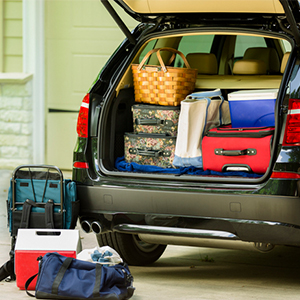The car is fully loaded with passengers and luggage ready for the winter holiday weekend. There are five seat belts, five passengers and at least five pieces of luggage. So you’re good to go, right? Not necessarily, says AAA. If your car is overweight, it could be potentially hazardous.
Auto manufacturers recommend a payload capacity for every vehicle; it’s the maximum combined weight of all passengers and cargo that can be carried safely. Exceeding the payload capacity stresses the tires, shocks, suspension and springs – four parts of the vehicle that keep it under control and on the road.
Is my car overweight?
 To determine how many passengers and how much total weight a vehicle can safely carry, look at the sticker on the driver-side doorjamb panel or refer to the vehicle owner’s manual. For example, a 2005 Nissan Quest minivan can hold seven passengers and has a payload capacity of 1,200 lbs. If each passenger weighs 200 pounds, the vehicle would be considered overloaded even without luggage. A 2006 Toyota Corolla can hold five passengers with a payload capacity of 850 pounds. A 2007 Lincoln Town Car can hold five passengers with a payload of 1,100 pounds.
To determine how many passengers and how much total weight a vehicle can safely carry, look at the sticker on the driver-side doorjamb panel or refer to the vehicle owner’s manual. For example, a 2005 Nissan Quest minivan can hold seven passengers and has a payload capacity of 1,200 lbs. If each passenger weighs 200 pounds, the vehicle would be considered overloaded even without luggage. A 2006 Toyota Corolla can hold five passengers with a payload capacity of 850 pounds. A 2007 Lincoln Town Car can hold five passengers with a payload of 1,100 pounds.
Overloaded car is a safety hazard even if well-maintained. When a properly inflated tire is carrying too much weight, it bulges at the bottom and the sidewalls can come into contact with the pavement. As the tire rolls, the sidewalls flex up and down, heating the tire and increasing the chance of a potentially dangerous blowout.
“Built-in safety mechanisms that help a driver maintain control at highway speeds won’t work properly when supporting more weight than they were designed to carry,” says Earl Baker, AAA Oregon/Idaho Approved Auto Repair Program coordinator. “In a turn or sudden swerve, an over-weighted vehicle will roll too far to the outside. This can cause the spring and shock system to rebound and push the vehicle back to the inside. This condition creates a rocking effect that can make steering so difficult that a driver may lose control of the vehicle.”
Follow these tips to stay safe when loading and driving with a heavy car:
- Check the sticker on the driver side doorjamb or owner’s manual for the payload capacity of the vehicle.
- Consider renting a car if you need more payload capacity.
- Be prepared for the vehicle to take longer to accelerate, brake and steer when fully loaded with passengers and luggage.
- Limit the number of passengers to the number of seat belts.
- Limit any load on top of your vehicle to 18″ high and to no more than 100 pounds. Roof top weight is part of the total payload.
- Be careful not to overload the trunk or rear cargo compartment.
Considering A new Car? Check out AAA Oregon AutoSource
Motorists looking to prepare their vehicle for winter can locate a AAA Approved Auto Repair facility staffed with certified technicians by visiting the Automotive page at www.AAA.com.
AAA members in need of roadside assistance may contact AAA anywhere in North America, 24 hours a day, 7 days a week by calling 1-800-AAA-HELP or requesting service online.

